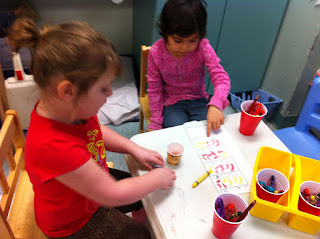

We've been working on our new school wide goal of increasing awareness of problem solving in the classroom. This applies for all children in the school from Kindergarten to Grade Eight. In Kindergarten, problem solving in math means using numbers to answer questions.
Some questions we have worked on are:
-What are different ways to make a number? Such as the number 5. There are many possibilities for these questions and not just one "right answer".
-Another example, If Alyssa has 10 fruits and vegetables all together...How many fruits could she have? How many vegetables?
-So we are working with numbers in a real life context. Children have to use their own thinking or work with a partner or small group to activity solve problems and are engaged in the process.

For Valentine's Day, we had the question: Barbie has 3 valentines. Dora has 10 valentines. Diego has moer than Barbie but less than Dora. How many valentines could Diego have?
Again, this is a thinking question that requires lots of thinking and skills to answer. It requires a "working sense of numbers" and a true understanding versus a "closed" question that has only one right answer.
In our class, we call ourselves "Math Wizards". We are all trying to become Math Wizards. We become a math wizard when we use pictures, numbers and words to solve problems. This will be an ongoing goal for all children in the classroom - to become a math wizard!

Here's some random pictures of our math work:
Mrs. Stefani








